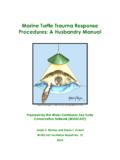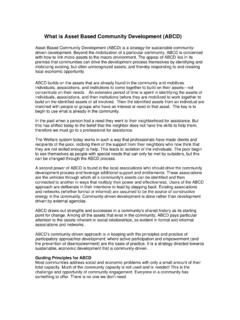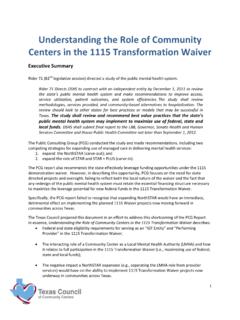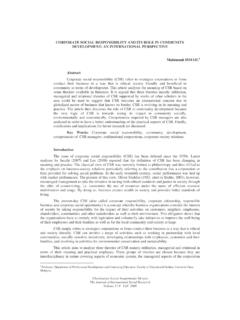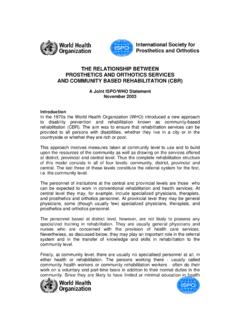Transcription of Guidelines for community-based ecotourism …
1 Guidelines forcommunity-basedecotourismdevelopmentW WF International|July 2001 Prepared byDr Richard Denman, The Tourism Company,11a High Street, Ledbury HR8 1DS, UKTel: +44 1531 635451 Fax: +44 1531 Tourism Company is a UK- based tourismconsultancy working in the field of tourism research,planning, development and marketing, with a specialismin rural tourism, ecotourism and protected thanks for support from the Rufford Foundationand from the MAVA IMAGE: E PARKER, WWF-UKContentsIntroduction1 The purpose of these Guidelines 1 What is community - based ecotourism ? 2 WWF s position 3 PART AConsidering whether ecotourism is an appropriate option41 Considering the potential conservation gain 4 Capacity building for ecotourism in Sabah.
2 Malaysia52 Checking the preconditions for ecotourism 6 community Conservancies in Namibia73 Adopting an integrated approach 8 Developing tools for responsible ecotourism in Brazil9 PART BPlanning ecotourism with communities and other stakeholders104 Finding the best way to involve the community 105 Working together on an agreed strategy 12 Principles and criteria for parks136 Ensuring environmental and cultural integrity 14An alternative way for the Mediterranean15 PART CDeveloping viable community - based ecotourism projects167 Ensuring market realism and effective promotion 16 Joint action with a tour operator178 Putting forward quality products 18 Creating integrated tourist offers in Romania19 PART DStrengthening benefits to the community and the environment209 Managing impacts 2010 Providing technical support 2111 Obtaining the support of visitors and tour operators 22 Codes of conduct in the Arctic2312 Monitoring performance and ensuring continuity 24 Further information251 IntroductionTourism is the world s largest industry.
3 It accounts for more than 10% of totalemployment, 11% of global GDP, and total tourist trips are predicted to increaseto billion by 2020. As such, it has a major and increasing impact on bothpeople and can be negative as well as positive. Inappropriate tourism develop-ment and practice can degrade habitats and landscapes, deplete naturalresources, and generate waste and pollution. In contrast, responsible tourismcan help to generate awareness of and support for conservation and localculture, and create economic opportunities for countries and is taking action to reduce negative impacts, and to encourage respon-sible tourism that enhances not only the quality of life, but also natural andcultural resources in purpose of these guidelinesThese Guidelines identify some general principles, and highlight some practicalconsiderations for community - based ecotourism .
4 They seek to provide a refer-ence point for field project staff, and to encourage a consistent , prevailing conditions and levels of knowledge about ecotourism varyconsiderably between countries and projects, and this will dictate how theguidelines are interpreted and used at a local Guidelines are not intended to be a detailed how to manual, but ratherstand as a collection of issues and topics to be considered and addressed. Insome countries, such as Brazil, WWF has been involved in the development ofspecific policies and good practice manuals for ecotourism which relate to localcircumstances and go into more detail.
5 Although the Guidelines are primarily intended for use within WWF, theymay also be of value to partner organisations and other agencies, and dem-onstrate to a wider audience, WWF s interest and approach in this field. Theyare based on experience obtained from WWF projects, and from publishedliterature and case studies. A list of helpful reference sources is also the text, information on individual WWF ecotourism projects isprovided in boxes. Though these are only referenced where their content isrelevant to a specific point, the information contained in them complementsthe Guidelines as a total, twelve Guidelines are presented.
6 These have been grouped into four sections that relate to different stages of community - based ecotourisminitiatives. These ecotourism is an appropriate option; with communities and other stakeholders; community - based ecotourism projects; to the community and the this is a broadly sequential ordering, all the issues raised by theguidelines should be considered together to obtain a comprehensive Panda in its natural habitat, Sichuan Province, MENDELL, WWF-UK2 What is community - based ecotourism ? ecotourism is a frequently debated term. Sometimes it is used simply toidentify a form of tourism where the motivation of visitors, and the sales pitchto them, centres on the observation of nature.
7 Increasingly, this general sectorof the market is called nature tourism . True ecotourism , however, requires aproactive approach that seeks to mitigate the negative and enhance the positiveimpacts of nature tourism. The International ecotourism Society defines eco-tourism as responsible travel to natural areas that conserves the environmentand sustains the well-being of local definition not only implies that there should be a recognition of, andpositive support for, the conservation of natural resources, both by suppliers andconsumers, but also that there is a necessary social dimension to term community - based ecotourism takes this social dimension a stagefurther.
8 This is a form of ecotourism where the local community has substantialcontrol over, and involvement in, its development and management, and a majorproportion of the benefits remain within the community . How the community is defined will depend on the social and institutionalstructures in the area concerned, but the definition implies some kind ofcollective responsibility and approval by representative bodies. In many places,particularly those inhabited by indigenous peoples, there are collective rightsover lands and resources. community - based ecotourism should thereforefoster sustainable use and collective responsibility.
9 However, it must also em-brace individual initiatives within the community . (These issues are coveredfurther under Guideline 4.)Some further general characteristics of ecotourism have been identified byUNEP and the World Tourism Organisation as: involving appreciation not only of nature, but also of indigenous culturesprevailing in natural areas, as part of the visitor experience; containing education and interpretation as part of the tourist offer; generally, but not exclusively, organised for small groups by small, special-ised and locally owned businesses (while recognising that foreign operatorsalso market and operate ecotourism ); minimising negative impacts on the natural and socio-cultural environment.
10 Supporting the protection of natural areas by generating economic benefitsfor the managers of natural areas; providing alternative income and employment for local communities; and increasing local and visitor awareness of definitions can be useful, what is more important is the appropriatenessand quality of action, not what it is processes involved in ecotourism include all aspects of planning, develop-ing, marketing and managing resources and facilities for this form of provision includes access to natural areas and cultural heritage, guidingand interpretative services, accommodation, catering, sales of produce andhandicrafts, and recreational and special interest activities, such as trail walking,photography and participatory conservation programmes.
